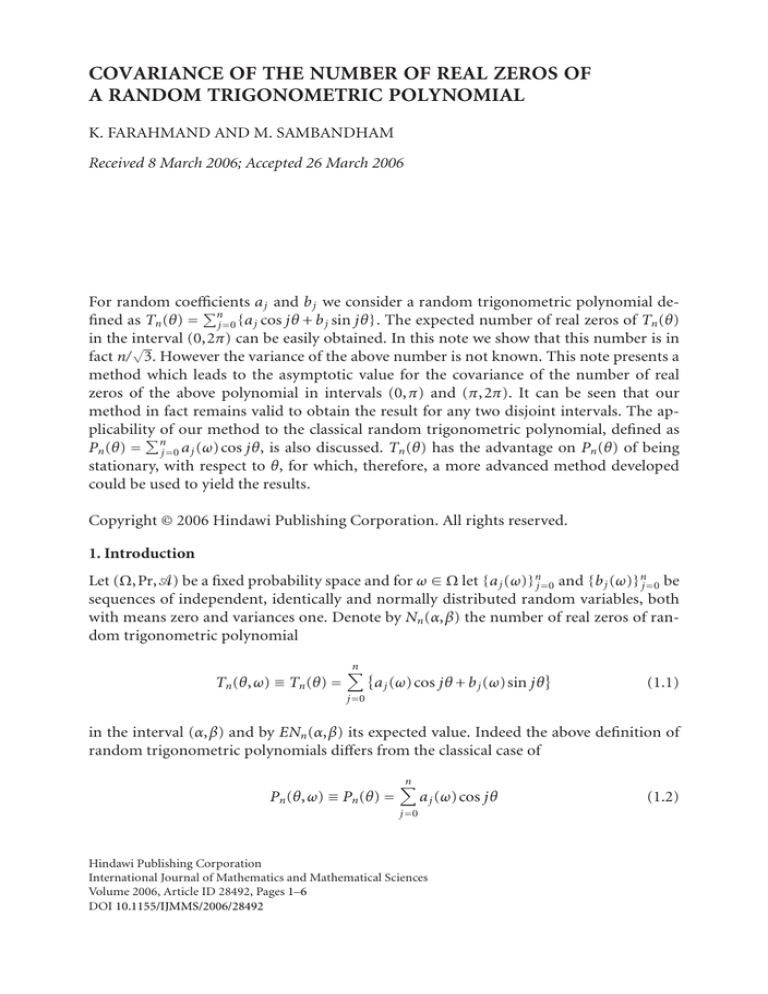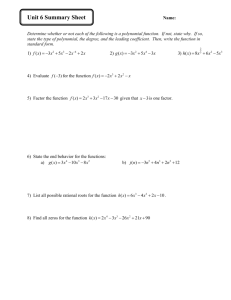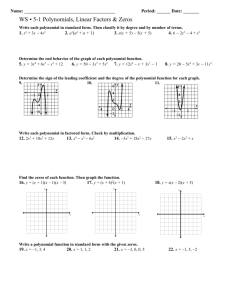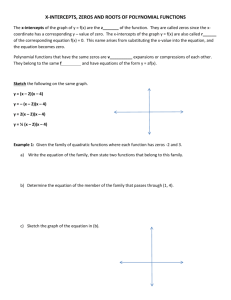
COVARIANCE OF THE NUMBER OF REAL ZEROS OF
A RANDOM TRIGONOMETRIC POLYNOMIAL
K. FARAHMAND AND M. SAMBANDHAM
Received 8 March 2006; Accepted 26 March 2006
For random coefficients
a j and b j we consider a random trigonometric polynomial de
fined as Tn (θ) = nj=0 {a j cos jθ + b j sin jθ }. The expected number of real zeros of Tn (θ)
in the interval
(0,2π) can be easily obtained. In this note we show that this number is in
√
fact n/ 3. However the variance of the above number is not known. This note presents a
method which leads to the asymptotic value for the covariance of the number of real
zeros of the above polynomial in intervals (0, π) and (π,2π). It can be seen that our
method in fact remains valid to obtain the result for any two disjoint intervals. The applicability
of our method to the classical random trigonometric polynomial, defined as
Pn (θ) = nj=0 a j (ω)cos jθ, is also discussed. Tn (θ) has the advantage on Pn (θ) of being
stationary, with respect to θ, for which, therefore, a more advanced method developed
could be used to yield the results.
Copyright © 2006 Hindawi Publishing Corporation. All rights reserved.
1. Introduction
Let (Ω,Pr,Ꮽ) be a fixed probability space and for ω ∈ Ω let {a j (ω)}nj=0 and {b j (ω)}nj=0 be
sequences of independent, identically and normally distributed random variables, both
with means zero and variances one. Denote by Nn (α,β) the number of real zeros of random trigonometric polynomial
Tn (θ,ω) ≡ Tn (θ) =
n
a j (ω)cos jθ + b j (ω)sin jθ
(1.1)
j =0
in the interval (α,β) and by ENn (α,β) its expected value. Indeed the above definition of
random trigonometric polynomials differs from the classical case of
Pn (θ,ω) ≡ Pn (θ) =
n
a j (ω)cos jθ
j =0
Hindawi Publishing Corporation
International Journal of Mathematics and Mathematical Sciences
Volume 2006, Article ID 28492, Pages 1–6
DOI 10.1155/IJMMS/2006/28492
(1.2)
2
Covariance of the number of real zeros
which has been extensively studied. The literature includes the original work of Dunnage
[3] which was later extended by Das [2] and Wilkins [8] and was reviewed by BharuchaReid and Sambandham [1] and recently by Farahmand [7]. They generally show that for
all sufficiently large n and for different classes of distributions of the coefficients or in
different cases, for√example, the level crossing case instead of zero crossings, ENn (0,2π) is
asymptotic to 2n/ 3. In particular the above work of Wilkins is of interest as it shows that
the error term involved in the asymptotic estimate is small and in fact is O(1). However,
finding the variance of the number of real zeros involves a different level of difficulties.
There have been several attempts, for instance, see [4] or [6], to obtain the asymptotic
value for the variance of Nn (0,2π) for Pn (θ). So far, the results are only in the form of
upper bounds. As far as the expected number of zeros is concerned the asymptotic value
of ENn (0,2π) for Tn (θ) and Pn (θ) is the same. Therefore, we conjecture that their variances are also the same. In addition, with the above assumptions of independence of the
coefficients a j (ω) and b j (ω) the inner term of Tn (θ) given in (1.1) has the property of
being stationary with respect to θ. This can be seen by evaluating its covariance function
as
E a j (ω)cos jθ + b j (ω)sin jθ a j (ω)cos j(θ + τ) + b j sin j(θ + τ)
= cos jθ cos j(θ + τ) + sin jθ sin j(θ + τ) = cos jτ.
(1.3)
Therefore it is natural to seek to evaluate the variance of number of zeros of Tn (θ) which
possess the above stationary property instead of Pn (θ) given in (1.2). We, however, are
unable to make any substantial progress in this direction. Instead, we obtain the covariance of the number of real zeros in the intervals (0, π) and (π,2π). As our main aim
remains to estimate the variance of Nn (0,2π) we will present our results and discussions
in such a way that they could be used to be generalized for variance. Although we are
considering two intervals (0, π) and (π,2π) our proof is also valid for any two disjoint
intervals. A small modification and some generalization to our analysis should lead to an
asymptotic value for the variance. Looking at our proof it suggests that our estimate for
the covariance will remain the same as for the variance. Furthermore, although we are
considering the polynomial Tn (θ) given in (1.1) as far as the results for the covariance,
and, therefore, the variance are concerned, it should remain invariant also for Pn (θ). For
random trigonometric polynomial Tn (θ) given in (1.1) we prove the following.
Theorem 1.1. With the above assumption of independent and Gaussian distribution of the
coefficients {a j (ω)}nj=0 and {b j (ω)}nj=0 the covariance of the number of real zeros of Tn (θ) is
cov Nn (0,π),Nn (π,2π) = 4n + O(1).
(1.4)
2. Covariance of the number of real zeros
For any two intervals (α,β) and (δ,γ) it is known that
E Nn (α,β)Nn (δ,β) =
β β ∞
α
δ
−∞
|xy | pθ1 ,θ2 (0,0,x, y)dx dx dθ1 dθ2 ,
(2.1)
K. Farahmand and M. Sambandham 3
where pθ1 ,θ2 (z1 ,z2 ,x, y) denotes the four-dimensional joint probability density function
of Tn (θ1 ), Tn (θ2 ), Tn (θ1 ), and Tn (θ2 ). For our purpose and using the above formula
to obtain the result for The covariance case, the two intervals (α,β) and (δ,γ) are disjoint. However the above formula and the following discussions remain valid for any two
intervals, whether or not they are overlapping. Let Π be the 4 × 4 variance-covariance
matrix of random variables Tn (θ1 ), Tn (θ2 ), Tn (θ1 ), and Tn (θ2 ) with cofactor Πi j of i jth
element. Then using the Gaussian assumption for the coefficients we can calculate the
above-required joint density function as
Π33 x2 + Π44 y 2 + Π34 + Π43 xy
exp −
.
Pθ1 ,θ2 (0,0,x, y) = 2 2|Π|
4π |Π|
1
(2.2)
In order to evaluate (2.1) further in (2.2) we let q = x Π33 / |Π| and s = y Π44 / |Π|. As
we will see later Π33 and Π44 are positive and therefore q and s are real. Hence from (2.2)
we obtain
∞
−∞
=
=
|xy | pθ1 ,θ2 (0,0,x, y)dx dx
∞
|Π|3/2
4π 2 Π33 Π44
∞
|Π|3/2
q2 + s2
Π34 + Π43
|qs| exp −
− qs dq ds
2
Π33 Π44
−∞
4π 2 Π33 Π44
−∞
(2.3)
q2 + s2 + 2ρqs
|qs| exp −
dq ds,
2
where ρ = (Π34 + Π43 )/2 Π33 Π44 . Now let ρ = cosφ, then from [7, page 97] the integral
appear in (2.3) can be evaluated as 4{1 + (π/2 − φ)cotφ}/ cos2 φ. Therefore for Gaussian
assumption the required formula in (2.1) is simplified as
1
ENn (α,β)Nn (γ,δ) = 2
π
Now we let
βδ
α
|Π|3/2 1 + (π/2 − φ)cotφ
Π33 Π44 cos2 φ
γ
An θ1 ,θ2 = cov Tn θ1 ,Tn θ2 ,
dθ1 dθ2 .
Cn θ1 ,θ2 = cov Tn θ1 ,Tn θ2 ,
(2.4)
Bn θ1 ,θ2 = cov Tn θ1 ,Tn θ2 ,
(2.5)
where Tn (θ) is the derivative of Tn (θ) with respect to θ. It is easy to show that the
cov{Tn (θ),Tn (θ)} = 0, also An (θ,θ) = var{Tn (θ)} = n and Bn (θ,θ) = var{Tn (θ)} = n(n +
1)(2n + 1)/6 are independent of θ. Therefore we can obtain the variance-covariance matrix of random variables Tn (θ1 ), Tn (θ2 ), Tn (θ1 ), and Tn (θ2 ) as
⎛
n
⎜ ⎜An θ1 ,θ2 ⎜
⎜
Π=⎜
⎜
0
⎜
⎜
⎝ Cn θ1 ,θ2
An θ1 ,θ2
n
−Cn θ1 ,θ2
0
0
−Cn θ1 ,θ2
n(n + 1)(2n + 1)
6
Bn θ1 ,θ2
Cn θ1 ,θ2
⎞
⎟
⎟
⎟
⎟
⎟
⎟.
Bn θ1 ,θ2
⎟
⎟
n(n + 1)(2n + 1) ⎠
0
6
(2.6)
4
Covariance of the number of real zeros
Let
sin (2n + 1) θ1 − θ2 /2
,
sin θ1 − θ2 /2
cos (2n + 1) θ1 − θ2 /2
.
=
sin{ θ1 − θ2 /2}
Sn θ1 ,θ2 =
Zn θ1 ,θ2
(2.7)
Then we can obtain the remaining elements of the above matrix as
An θ1 ,θ2 ≡ An θ2 ,θ1 =
n
j =0
Cn θ1 ,θ2 ≡ −Cn θ2 ,θ1 =
n
Sn θ1 ,θ2 − 1
,
2
cos j θ1 ,θ2 =
j sin j θ1 − θ2
j =0
Sn (θ1 ,θ2 )cot θ1 − θ2 /2
(2n + 1)Zn θ1 ,θ2
+
,
=−
4
4
Bn θ1 ,θ2 ≡ Bn θ2 ,θ1 =
n
j 2 cos j θ1 − θ2
j =0
=−
−
Sn θ1 ,θ2
(2n + 1)2 (2n + 1) Sn θ1 ,θ2 −
+
Zn θ1 ,θ2 cot
8
8
4
Sn θ1 ,θ2
cot2
4
θ1 − θ2
2
θ1 − θ2
2
.
(2.8)
Now we are in the position to proceed with the proof of our theorem.
3. Proof of the theorem
From (2.6) we can obtain the determinate of Π as
|Π| = n2
n(n + 1)(2n + 1)
6
2
− n2 Bn2 θ1 ,θ2
n(n + 1)(2n + 1)
n(n + 1)(2n + 1) 2
− 2nCn2 θ1 ,θ2
− A2n θ1 ,θ2
6
6
(3.1)
+ A2n θ1 ,θ2 Bn2 θ1 ,θ2 + 2An θ1 ,θ2 C 2 θ1 ,θ2 Bn θ1 ,θ2 + Cn4 θ1 ,θ2 .
Also the required cofactors are
Π43 = Π34 = n2 Bn θ1 ,θ2 − A2 θ1 ,θ2 Bn θ1 ,θ2 − A θ1 ,θ2 C 2 θ1 ,θ2 ,
Π33 = Π44 =
n(n + 1)(2n + 1) 2 n3 (n + 1)(2n + 1)
− n2 C 2 θ1 ,θ2 +
An θ1 ,θ2 .
6
6
(3.2)
(3.3)
K. Farahmand and M. Sambandham 5
Now we use the advantage that θ1 and θ2 are disjoint and therefore Sn (θ1 ,θ2 ), Zn (θ1 ,θ2 )
and cot(θ1 − θ2 ) are bounded. Therefore from (3.1)–(3.3) we obtain
|Π| ∼ n2
|Π33 | ∼
n(n + 1)(2n + 1)
6
2
,
n3 (n + 1)(2n + 1)
,
6
(3.4)
|Π34 | ∼ Π43 ∼ n2 Bn θ1 ,θ2 = O n4 Sn θ1 ,θ2 .
In order to evaluate the integral that appears in (2.4) we note that from (3.4)
Π + Π43
ρ = 34
−→ 0
2 Π33 Π44
(3.5)
as n → ∞ and therefore for sufficiently large n,
φ = arccosρ −→
π
.
2
(3.6)
This summarizes the value of (2.4) to
E Nn (α,β)Nn (δ,γ) =
βγ
α
δ
|Π|3/2
π 2 Π33 Π44
dθ1 dθ2 .
(3.7)
With our assumptions of our theorem it turns out that |Π|, Π33 , and Π44 are independent
of θ1 and θ2 . Also for all sufficiently large n,
|Π| ∼
n4 (n + 1)2 (2n + 1)2 n8 n7
∼
+ ,
36
9
3
(3.8)
n3 (n + 1)(2n + 1) n5
∼
.
Π44 ∼ Π33 ∼
6
3
Therefore
E{Nn (0,π)Nn (π,2π)} ∼
|Π|3/2
Π33 Π44
n8 /9 + n7 /3
∼
(n5 /3)2
3/2
∼
n2 9n
+ .
3
2
(3.9)
In order to proceed we need to find ENn (0,π) and ENn (π,2π). To this end we use the
Kac-Rice formula and because of the stationary property of Tn (θ) mentioned above, we
are able to obtain an estimate with small error easily. Using a same method as [5] and
since cov(Tn (θ),T (θ)) = 0, we have
1
ENn (0,π) =
π
where
π
0
B
dθ,
πA
(3.10)
A2 = var Tn (θ) = n,
B 2 = var Tn (θ) =
n(n + 1)(2n + 1)
.
6
(3.11)
6
Covariance of the number of real zeros
Therefore
n(n + 1)(2n + 1)
√
ENn (0,π) =
=
6n
√
n2 n 1
n
1
3
.
+ + =√ +
+O
3 2 6
4
n
3
(3.12)
Hence by (3.9), (3.12) and since a similar result to (3.12) can be obtained for ENn (π,2π),
we can obtain
cov Nn (0,π),Nn (π,2π) ∼
√
n2 9n
n
3
− √ +
+
+ O(1)
3
2
4
3
2
∼ 4n + O(1).
(3.13)
This completes the proof of the theorem.
References
[1] A. T. Bharucha-Reid and M. Sambandham, Random Polynomials, Probability and Mathematical
Statistics, Academic Press, Florida, 1986.
[2] M. Das, The average number of real zeros of a random trigonometric polynomial., Proceedings of
the Cambridge Philosophical Society 64 (1968), 721–729.
[3] J. E. A. Dunnage, The number of real zeros of a random trigonometric polynomial, Proceedings of
the London Mathematical Society 16 (1966), 53–84.
[4] K. Farahmand, On the variance of the number of real roots of a random trigonometric polynomial,
Journal of Applied Mathematics and Stochastic Analysis 3 (1990), no. 4, 253–261.
, Number of real roots of a random trigonometric polynomial, Journal of Applied Mathe[5]
matics and Stochastic Analysis 5 (1992), no. 4, 307–313.
, On the variance of the number of real zeros of a random trigonometric polynomial, Journal
[6]
of Applied Mathematics and Stochastic Analysis 10 (1997), no. 1, 57–66.
, Topics in Random Polynomials, Pitman Research Notes in Mathematics Series, vol. 393,
[7]
Longman, Harlow, 1998.
[8] J. E. Wilkins Jr., Mean number of real zeros of a random trigonometric polynomial, Proceedings of
the American Mathematical Society 111 (1991), no. 3, 851–863.
K. Farahmand: Department of Mathematics, University of Ulster at Jordanstown, Co. Antrim,
BT37 0QB, UK
E-mail address: k.farahmand@ulster.ac.uk
M. Sambandham: Department of Mathematics, Morehouse College, Atlanta, GA 30314, USA
E-mail address: msamband@morehouse.edu









